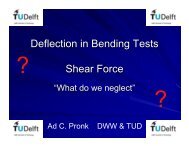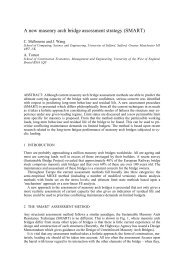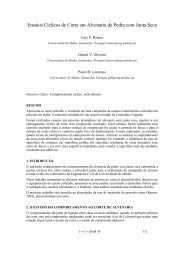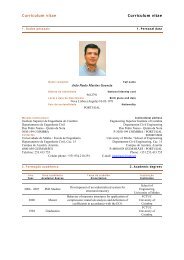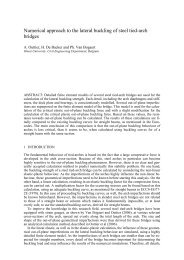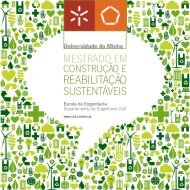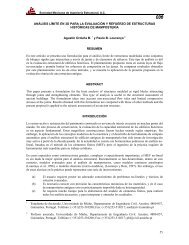Sustainable Construction A Life Cycle Approach in Engineering
Sustainable Construction A Life Cycle Approach in Engineering
Sustainable Construction A Life Cycle Approach in Engineering
You also want an ePaper? Increase the reach of your titles
YUMPU automatically turns print PDFs into web optimized ePapers that Google loves.
Interpretation of the various load deflection curves <strong>in</strong>dicates a similar behaviour <strong>in</strong> general for<br />
the different types of fibres. Beyond peak load, a reduction of the stiffness of the composite was<br />
observed, supplemented by a quasi ductile behaviour. The area under the load deflection curves<br />
<strong>in</strong>creased as the volume fraction of the fibres added <strong>in</strong>creased.<br />
The highest peak loads for all volume fractions were recorded for IFCA (Dramix RC-80/30-<br />
BP - hooked ended fibres, l/d: 79) mixes, while the lowest peak load was achieved by IFCB (La<br />
Gramigna 100x50 - hooked ended fibres l/d: 50) mixes, (except for the 2% volume fraction).<br />
Assessment of the energy absorption up to failure for all mixes gave <strong>in</strong>sight on the toughness<br />
of the various specimens tested. Toughness <strong>in</strong>creased as more fibres were added to the fresh<br />
mix. IFCA (Dramix RC-80/30-BP) mixes exhibited the highest level of toughness for all volume<br />
fractions. The toughness exhibited by TFRC (shredded tyre fibres) mixes was higher than<br />
that for IFCB (La Gramigna 100x50) and IFCC (Fibeton 8-40) mixes for all fibre volume<br />
fractions. This is attributed to the aspect ratio of the fibres. An <strong>in</strong>vestigation of the crack open<strong>in</strong>g<br />
<strong>in</strong>dicated that waste tyre fibres develop cracks at a load lower than other fibres.<br />
The <strong>in</strong>vestigation <strong>in</strong>dicated that the use of shredded tyre fibres leads to a small contribution with<br />
respect to compressive strength. Ga<strong>in</strong>s of up to 2.8kN (7.83%) with respect to the control mix,<br />
were recorded when us<strong>in</strong>g a volume fraction of 1.5%. A more significant improvement was<br />
noted when test<strong>in</strong>g <strong>in</strong> flexure. In the case of the 1.5% volume fraction, a higher peak load<br />
(4.6kN – 33%) with respect to the control mix was observed for TFRC. Composites conta<strong>in</strong><strong>in</strong>g<br />
shredded tyre fibres showed a higher level of toughness than La Gramigna 100x50 (IFCB -<br />
hooked ended fibres, l/d: 50) and Fibeton 8-40 (IFCC - crimped fibres, l/d: 50) fibres. However<br />
due to the lack of end anchorage, fibre slippage resulted <strong>in</strong> the development of wider cracks.<br />
The current research can be considered as a prelim<strong>in</strong>ary <strong>in</strong>vestigation to determ<strong>in</strong>e the potential<br />
use of the shredded waste tyre fibres <strong>in</strong> concrete.<br />
The outcome of the experimental <strong>in</strong>vestigation, and support<strong>in</strong>g literature, <strong>in</strong>dicate that<br />
various aspects that can be considered <strong>in</strong> further detail. These <strong>in</strong>clude the consideration of a<br />
larger number of test samples; consideration of a larger number of test variables; the <strong>in</strong>clusion<br />
of different volume fractions; assessment of the fibre aspect ratio; the assessment of fresh<br />
concrete properties and mix<strong>in</strong>g methodology; consideraion of additional tests on hardened<br />
concrete; durability assessment; the potential use <strong>in</strong> different types of concrete mixes; and the<br />
assessment of potential applications of waste tyre fibres.<br />
REFERENCES<br />
ACI Committee 544. 1993. Guide for Specify<strong>in</strong>g, Proportion<strong>in</strong>g, Mix<strong>in</strong>g, Plac<strong>in</strong>g, and F<strong>in</strong>ish<strong>in</strong>g Steel Fiber<br />
Re<strong>in</strong>forced Concrete. A.C.I. Materials Journal, 90 (1), pp 94-103.<br />
Al-Ghamdy, D. O., Wight, J. K. & Tons, E. 1994. Flexural toughness of steel fibre re<strong>in</strong>forced concrete.<br />
Journal of K<strong>in</strong>g Abdul-Aziz University: eng<strong>in</strong>eer<strong>in</strong>g sciences, 6 pp 81-97.<br />
Basel Convention Technical Committee. October 2000. Technical Guidel<strong>in</strong>es on the Identification and<br />
Management of Used Tyres. Basel: UNEP.<br />
Bentur, A., & M<strong>in</strong>dness, S. 1990. Fibre Re<strong>in</strong>forced Cementitious Composites. Albany, NY: Elsevier Publish<strong>in</strong>g.<br />
Blumenthal, M. 2006. Scrap Tyre markets <strong>in</strong> the United States. Wash<strong>in</strong>gton, DC: Rubber Manufacturers<br />
Association.<br />
ETRMA. 2007. End of <strong>Life</strong> Tyres – A valuable resource with grow<strong>in</strong>g potential 2007 Edition. Brussels:<br />
European Tyre & Rubber Manufacturers Association.<br />
Farrugia, C. 2009. Waste Tyre Fibres – Investigat<strong>in</strong>g the potential use <strong>in</strong> concrete. B.E. & A. (Hons.) Unpublished<br />
dissertation, University of Malta.<br />
Inga, S. & Inga, K. 2006. Comparison of End-of-life Tyre Treatment Technologies: <strong>Life</strong> <strong>Cycle</strong> Inventory<br />
Analysis. Environmental research, eng<strong>in</strong>eer<strong>in</strong>g and management, 35 (1), pp. 52-60.<br />
Integrated Waste Management Board. 2003. Assessment of Markets for Fibre and Steel Produced From<br />
Recycl<strong>in</strong>g Waste Tires. Sacramento, CA: California Environmental Protection Agency.<br />
Laskar, A., & Talukdar, S. 2008. Rheology of Steel Fibre Re<strong>in</strong>forced Concrete. Asian Journal of Civil<br />
Eng<strong>in</strong>eer<strong>in</strong>g (Build<strong>in</strong>g and Hous<strong>in</strong>g), 9 (2), pp. 167-177.<br />
88



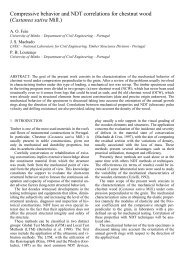
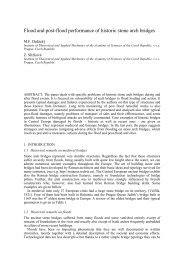
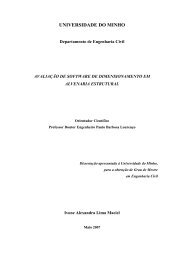
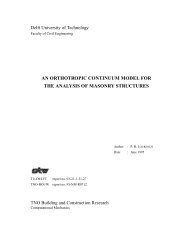

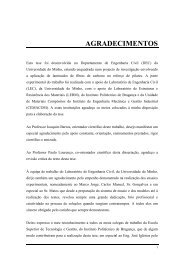

![Weibull [Compatibility Mode]](https://img.yumpu.com/48296360/1/190x134/weibull-compatibility-mode.jpg?quality=85)
